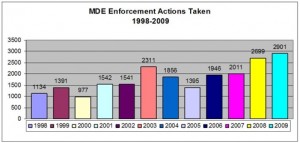28
Md. Dept. of Environment Report Shows Enforcement, Cases Rise
Each year, on or before October 1, the Maryland Department of the Environment (MDE) is required, under Title 1, Subtitle 3 of the Maryland Environmental Article, §1-301(d), to release a thorough report that documents enforcement activities “conducted by the Department during the previous fiscal year.”
The report has been released annually for the past 13 years, and the most recent report covers Fiscal Year 2009, from July 2008 through June 2009. The report is extremely detailed and has a very specific format. It is divided into three sections and in its entirety reflects the performance results for regulatory programs overseeing the environment and the amount of money collected by these programs in the form of penalties. There are 28 areas of enforcement and 15 programs covered in the report (see page 19 of the report).
Most enforcement actions are taken by the Air and Radiation Management Administration (ARMA), the Waste Management Administration (WAS) and the Water Management Administration (WMA). The report defines the regulatory authority of these administrations in the following way:
1). Air: air pollution and radiation programs.
2). Waste: oil control, solid and hazardous waste management, sewage sludge utilization, scrap tire recycling, lead poisoning prevention, natural wood waste recycling, and Superfund remediation programs.
3). Water: This includes drinking water, tidal and non-tidal wetlands, wastewater discharges, coal and mineral mining, oil and gas exploration and production, water appropriation, waterway and floodplain construction, dam safety, stormwater management and sediment and erosion control programs.
Money collected by the different programs (within these three main administrations) in the form of penalties is deposited into seven major state funds: the Clean Air Fund, the Oil Disaster Containment, Clean-Up and Contingency Fund, the Nontidal Wetland Compensation Fund, Hazardous Substance Control Fund (handles identifying, monitoring, and controlling the proper disposal, storage, transportation, or treatment of hazardous substances), money recovered from responsible parties under Environmental Title, §7-221 (covers parties that release or threatened to release hazardous substances), the Sewage Sludge Utilization Fund and the Clean Water Fund.
This year in total, the MDE oversaw 117,421 entities and reported that the total number of enforcement actions taken by environmental programs increased by 7 percent over Fiscal Year 2008. The report also stated that MDE inspected 17% more sites.
 Enforcement and compliance actions are separate for the three main administrative bodies, although most regulate through inspections, audits and spot checks. Officials generally allow companies to correct minor violations, but more significant violations discovered after inspection or recurring minor violations leads to penalties, injunctions, corrective orders, or criminal sanctions.
Enforcement and compliance actions are separate for the three main administrative bodies, although most regulate through inspections, audits and spot checks. Officials generally allow companies to correct minor violations, but more significant violations discovered after inspection or recurring minor violations leads to penalties, injunctions, corrective orders, or criminal sanctions.
Penalties collected last fiscal year from environmental violators totaled $6,516,601. This was an increase of $2,546,326 from Fiscal Year 2008. A press release from MDE explains that a “$4 million settlement with ExxonMobil Corporation for the release of more than 25,000 gallons of gasoline at a service station in the Jacksonville area of Baltimore County,” is included in that sum of collected penalties.
Despite these successes, there is an underlying problem expressed in this year’s report: “MDE’s increased enforcement activity has created a much larger workload for the attorneys assigned by the Office of the Attorney General to MDE.” The report compares Calendar Year 2007, in which roughly 340 enforcement cases were referred for legal action with the 816 cases referred in 2009. The report states that because staff cannot keep up with this increase in cases, there were 325 cases that had not been addressed as of January 1, 2010. Furthermore, the report shows that there were 51,587 sites inspected in Fiscal Year 2009 and 157.4 inspectors for all three regulatory administrations.
Graphic Credit: MDE FY 2009 Annual Enforcement and Compliance Report
About Us
Our Stories
- Md. Officials May Temporarily Lift Ban on Female Crab Harvest in Bay
- Scientists, Environmentalists Question Readiness of Chesapeake Bay Disaster Plans
- Inner Harbor Water: Unsafe Bacteria Levels, Test Shows
- Swimmers’ Impressions of Bay Not Always in Sync With Its Health, Scientists Say
- Chesapeake Bay Swim Attracts Hundreds in Balmy Conditions, But Course Includes ‘Dead Zone’
















